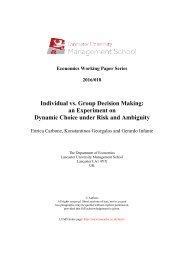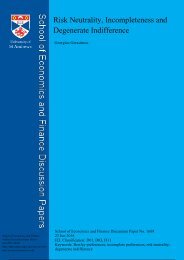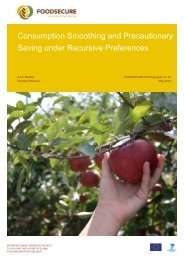Dual Random Utility Maximisation
n?u=RePEc:san:wpecon:1605&r=upt
n?u=RePEc:san:wpecon:1605&r=upt
Create successful ePaper yourself
Turn your PDF publications into a flip-book with our unique Google optimized e-Paper software.
More in general, the source of non-uniqueness when rankings have symmetric<br />
probabilities is the following. Suppose that, given the rankings r 1 and r 2 , the set of<br />
alternatives can be partitioned as X = A 1 ∪ ... ∪ A n such that if a ∈ A k , b ∈ A l and<br />
k < l, then a ≻ i b for i = 1, 2. Now construct two new rankings r<br />
1 ′ and r′ 2<br />
in the following<br />
manner. Fix A k , and for all a, b ∈ A k set a ≻ i b if and only if a ≻ j b, i ̸= j, while<br />
for all other cases r<br />
1 ′ and r′ 2 coincide with r 1 and r 2 (i.e. r<br />
1 ′ and r′ 2<br />
swap the subrankings<br />
( )<br />
within A k ). Then it is clear that the probabilities generated by r<br />
1 ′ , r′ 2, 1 2<br />
are the same as<br />
)<br />
1<br />
those generated by<br />
(r 1 , r 2, 2<br />
. Apart from these “swaps”, the identification is unique.<br />
7 Concluding remarks<br />
We have argued that the dual <strong>Random</strong> <strong>Utility</strong> Model constitutes a parsimonious framework<br />
to represent the variability of choice in many contexts of interest, both in the fixed<br />
state probability version and in the new menu-dependent probability version.<br />
The properties at the core of our analysis are simple and informative about how<br />
choices react to the merging, expansion and contraction of menus and thus may provide<br />
the theoretical basis for comparative statics analysis and for inferring behaviour<br />
in larger menus from behaviour in smaller ones, or vice-versa.<br />
The menu-dependent version of the model, while still quite restrictive (as demonstrated<br />
by our characterisation), significantly extends the range of phenomena that the<br />
model can encompass, because it does not need to satisfy the full Regularity property<br />
but only a ‘modal’ version of it: as a consequence, for example the attraction and the<br />
compromise effects and Luce and Raiffa’s ‘frog legs’ types of anomalies can be described<br />
as dual random utility maximisation.<br />
References<br />
[1] Apesteguia, Jose and Miguel Angel Ballester (2016) “Single-crossing <strong>Random</strong><br />
<strong>Utility</strong> Models", mimeo<br />
29






